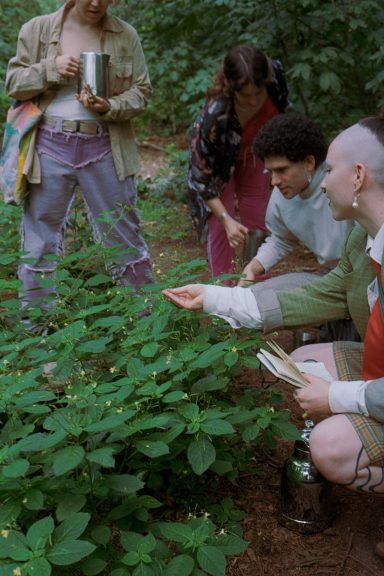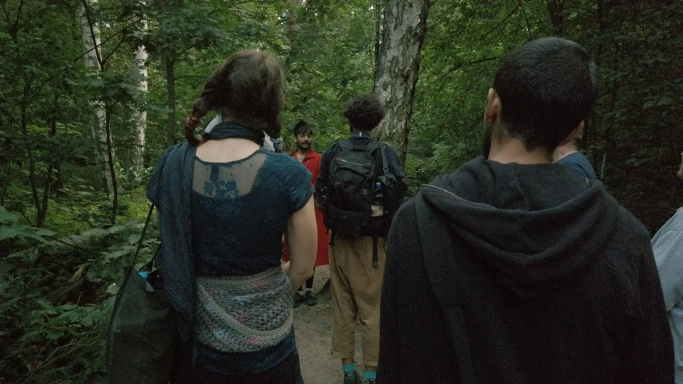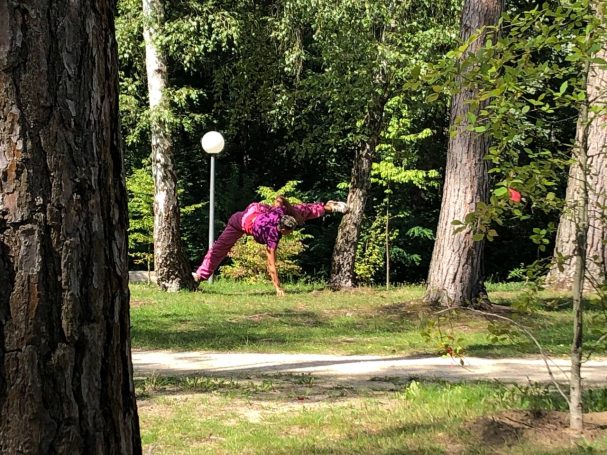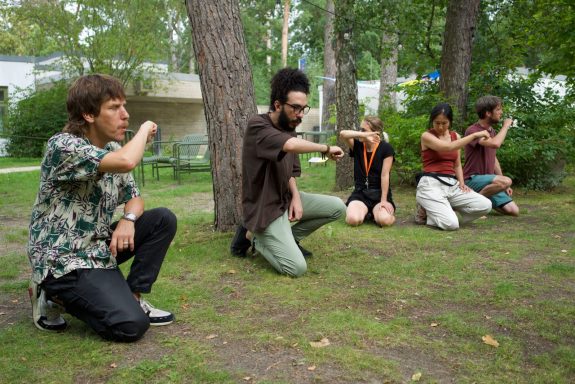Interdisciplinary Artistic Residency and Festival
Berlin | Museum Kesselhaus Herzberge
31 Aug & 1 Sep 2024
3 pm - 10 pm

ONSITE 2022
Impressions of last year's festival | Full program and list of works below
Saturday, 2 September 2023, 5 pm
Sunday, 3 September 2023, noon–5 pm
Free entry
After a two-week residency in the Brücke-Museum's Waldraum (Forest Room), the 20 participating artists will present their works. The interdisciplinary artworks were developed in engagement with the history of the site, in dialogue with the surrounding nature. They range from multimedia performances and sound installations to workshops and interactive theater pieces.
The majority of the artists live in Berlin and have roots in nine different countries. This year, in addition to the Brücke-Museum, Po:era is also cooperating with the art group of the nearby LebensWerkGemeinschaft.
The project is part of the initiative DRAUSSENSTADT, funded by the Senate Department for Culture and Europe and the Stiftung.

Samstag, 2. September 2023, 17–21 Uhr
Sonntag, 3. September 2023, 11–17 Uhr
Freier Eintritt
Nach einer zweiwöchigen Residency im Waldraum des Brücke-Museums präsentieren die 20 teilnehmenden Künstler*innen ihre Arbeiten. Die interdisziplinären Kunstwerke wurden in Auseinandersetzung mit der Geschichte des Ortes und im Dialog mit der umgebenden Natur entwickelt. Sie reichen von Multimedia-Performances über Klang-Installationen bis hin zu Workshops und interaktiven Theaterstücken.
Die Künstler*innen leben zum Großteil in Berlin und sind in neun unterschiedlichen Ländern verwurzelt. In diesem Jahr kooperiert Po:era neben dem Brücke-Museum auch mit der Kunstwerkstatt der LebensWerkGemeinschaft
unweit des Museums.
Das Projekt ist Teil der Initiative DRAUSSENSTADT, gefördert von der Senatsverwaltung für Kultur und Europa und der Stiftung für kulturelle Bildung und Kulturberatung.

Performances & Workshops
Saturday - Samstag | 02.09.2023
Anderson Kaltner Live Set - 17:00
Po:era Welcome de/en - 18:00
Julia Romas - 18:30
Cztery Oczy (Four Eyes) de/en/pl
Interactive Journeys - 18:30 - 19:30
Hamza Mohammed Beg
mr. mohammed presents intermediary object whispering english
Jee-Ae Lim
Attending to the listening of others english
Paola Báscon
Reflecting Nature, Entangling Bodies english
Rayne
A cigarette: A bundle stickS :: a Cuttingboard: An alter english
Riley Davidson
Grief Garden Party english
Samaquias Lorta - 18:45
All Around Us
Maju Passos - 19:30
Owner of Herself
in collaboration with Celo Dut
Omar Adel - 20:00
If a Tree Falls (notes on observation)
Sunday - Sonntag | 03.09.2023
12:00 - 15:00 - Interactive Journeys
Gadutra
What did I forget here? english
Hamza Mohammed Beg
mr. mohammed presents intermediary object whispering english
Jee-Ae Lim
Attending to the listening of others english
Paola Báscon
Reflecting Nature, Entangling Bodies english
Rayne
A cigarette: A bundle stickS :: a Cuttingboard: An alter english
Riley Davidson
Grief Garden Party english
13:00 - Viviane Tabach Workshop with Clay:
Instructions to Shape the Impermanence | en
14:00 - Samaquias Lorta All Around Us
15:00 - Thomas Mayer Workshop & Performance
DON’T TOUCH
16:00 - Secret Performance
INSTALLATIONS - INSTALLATIONEN
Raquel Rosildete Traga e Traduz | Wearable Sun
Paul Wiersbinski I used to think… in collaboration with Eva Pedroza
Andressa Cantergiani Trepadeira in collaboration with F. Gregorio
Ana Sofia Calixto Madness Serenade
Chelsea Leventhal Any number of warnings
Omar Adel If a Tree Falls (notes on observation)
Samaquias Lorta All Around Us
PAINTINGS / SCULPTURES
Lale Willan Parasite-Paintings
in symbiosis with drawings by Janis Prauser
Julia Romas Cztery Oczy (Four Eyes)
in collaboration with Karin Frey
Viviane Tabach Challenging Legacies: Living Monuments
in collaboration with Kunstgruppe of LebensWerkGemeinschaft
Yann Colonna Who’s missing? | Rückkehr der Hybride
The Site
We understand site-specific research as the investigation of the relationship of a place with both the territory or space it is embedded in and the subjects that inhabit or pass through it. As living beings, we claim territories by fighting over them or working them, by confining them or defining them. We desert them or breathe life into them. So do the non-living: A mountain casting a shadow on a hot afternoon defines a new territory in which both humans and non-humans share a sense of relief when the temperature drops and the humidity rises, when new smells and colours emerge, and the living world finds itself really present in the shaded reality created by the animated material world.
In their apparent static locality, the experience of sites can be as multiple and ephemeral as the personal relationships established with them. A forest, for example, feels very different from the perspective of the hunter, botanist, walker, nature enthusiast or fairy-tale storyteller. And as the biologist Jakob von Uexküll noticed: Even the stem of a flower becomes a very versatile element in such forest, whether it is experienced in relation to the environment of the boy picking the flower to put it behind his ear, the ant using it as a path on its way to the goblet, the larvae drilling holes in it to reach the juices that make its liquid house or finally the deer that simply chews and swallows it as food. And, of course, the forest can also turn into an archaeological site that tells us stories of a distant past. It points us to the origins of human civilizations, or provides proof of the existence of species that have been extinct for thousands of years.
How do these distant pasts on site resonate in our lives still today?
And what might be the traces of our existence to be found in the distant future?
The site of the residency and festival – the area connecting Brücke-Museum and LebensWerkGemeinschaft in Berlin-Dahlem - serves as the starting point of the artistic research and creation during the residency period. The museum and workshops are located on the edge of the 777 hectares forest district “Dachsberg”, embedded in a total of 3.000 hectares of the city forest “Grunewald” in the south-west of Berlin.
When engaging with the site we want to encounter nature as both creator and destroyer and avoid describing it as an exploitable resource, helpless victim of human destruction, or caring Mother Earth. We want to discuss what constitutive role animals, plants and art play when it comes to the history(s) of domestication and cultivation, of education, of subjectification and objectification. We want to question the function and aesthetics of producing binary spaces and concepts such as nature/culture, own/foreign, will/instinct. As part of the intercultural and inclusive encounter, we question the belonging to imagined and actual territories that manifest themselves not only in the demarcation between humans and nature, but also along old and new struggles for social participation as well as the visibility and recognition of plurality in the culture industry.

Brücke Museum
The Brücke Museum houses the world's largest collection of works by members of the group Die Brücke ("The Bridge"), an early 20th-century German expressionist movement. Opened in 1967, the Brücke Museum features around 400 paintings and sculptures and several thousand drawings, watercolours and prints by members of Die Brücke, the movement founded in 1905 in Dresden. The museum conducts research into works by the founding members of the movement and their early 20th-century milieu and contemporaries. It presents both a continually changing selection of its own works, and frequent special exhibitions of works on loan. The Brücke Museum initiates and supports projects that are dedicated to the artists’ group Brücke and the museum’s environment, or those projects which explore interdisciplinary and contemporary perspectives on the museum and the surrounding forest.
The participants of the residency and festival will be hosted in the Waldraum (“forest room”), designed as a special place for experiencing nature, social encounters and artistic production. Its open and transparent construction allows an unobstructed view of the surrounding nature.

LebensWerkGemeinschaft
The LebensWerkGemeinschaft is a working and living space for people with assistance needs.
"We see ourselves as a community of people who have the common goal of offering people with assistance needs a holistically designed living and working environment and in this way contribute to the inclusion and further development of people."
Currently 17 people are active members of the art workshop in Berlin-Dahlem, just a five-minute walk away from the Brücke Museum. During the residency period the artists of LebensWerkGemeinschaft share their observations from excursions in the Grunewald Forest which inspire and stimulate them to find an artistic language, on site or later in the workshop. They define their artistic process as bridges to other worlds, based on their individual access to the realm of creativity, spontaneity and the immediate emotional world.
The workshops, tools and outside areas of LebensWerkGemeinschaft will be accessible for the participating artists in residence throughout the research period and for presentations during the festival.
Hosts - Curators
The residency and festival are hosted by the interdisciplinary collective Po:era. They follow the creative process of the participants for the whole period of the residency.
Po:era
Lucas Lacerda and Daniel Weyand create with Po:era immersive experiences at the intersection of performance, sound and audio-visual art. In their site-specific research they engage with the material, imaginary and living qualities of a space to uncover its stories and paths to the future or to create connective, sense-based encounters with its human and non-human inhabitants. In 2022 the actor / director and filmmaker / anthropologist hosted Onsite Herzberge, the first edition of the site-specific residency and art festival in Berlin-Lichtenberg.
Guest Artists - Facilitators
The invited national and international artists guide the shared and individual processes during focus sessions and ongoing labs. They provide practical help and methodological tools.
Gob Squad
Gob Squad is a seven-headed monster, an arts collective with seven bosses, with a multiple split personality: hermaphrodite, bi-national and bilingual, a patchwork family, a Berliner institution and a social utopia. Gob Squad have been devising, directing and performing together since 1994, working where theatre meets art, media and real life. Always on the hunt for beauty amidst the mundane, they place their work at the heart of urban life. Everyday life and magic, banality and idealism, reality and entertainment are all set on a collision course and the unpredictable results are captured on video. Motivated by a desire to elevate the everyday and empower audience members to step beyond their traditional role as passive spectators. Sean Patten is one of the core members of the group.
Club Real
The artists group Club Real was founded in 2000 and is devising and realising participatory site-specific projects: Installations, one-to-one encounters, political role play scenarios and participatory urban development projects invite visitors to help shape alternative concepts of reality. Since 2017, Club Real has been working on the participatory political experiment Organisms Democracy on various sites including Berlin, Vienna and Gelsenkirchen. Equal Political Rights for all Living Beings - this is the radical demand of the project, which is implemented in real terms within the framework of all the Organisms Democracy projects.
The cycle of work is documented and continued on the website organismdemocracy.org.

A project by Po:era in cooperation with

Funded by:



Wir benötigen Ihre Zustimmung zum Laden der Übersetzungen
Wir nutzen einen Drittanbieter-Service, um den Inhalt der Website zu übersetzen, der möglicherweise Daten über Ihre Aktivitäten sammelt. Bitte überprüfen Sie die Details in der Datenschutzerklärung und akzeptieren Sie den Dienst, um die Übersetzungen zu sehen.





































